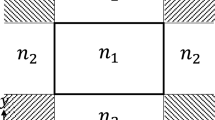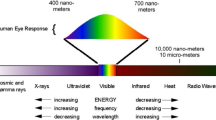In this paper, the Discrete Sources Method has been extended to describe the influence of the geometry asymmetry of a core-shell particle accounting for the effect of spatial dispersion inside the plasmonic metal shell. We found that varying the plasmonic shell thickness has more influence on the near field intensity distribution then on the average enhancement factor. Besides, we demonstrates that the effect of spatial dispersion can decrease the near field intensity up to 60% of its value and it provides a small blue shift.
Similar content being viewed by others
Change history
02 December 2021
A Correction to this paper has been published: https://doi.org/10.1007/s10598-021-09538-7
References
E. T. Jaynes and F.W. Cummings, “Comparison of quantum and semiclassical radiation theories with application to the beam maser,” Proc. IEEE, 51, No. 1, 89–109 (1963).
M. T. Tavis, A Study of an N Molecule Quantized-Radiation-Field Hamiltonian, Dissertation; https://arxiv.org/abs/1206.0078 (2012).
M. I. Makin, Jared H. Cole, Charles D. Hill, Andrew D. Greentree, and Lloyd C. L. Hollenberg, “Time evolution of the onedimensional Jaynes-Cummings-Hubbard Hamiltonian,” Phys. Rev. A, 80 (2009).
Guilherme M. A. Almeida and Andre M. C. Souza, “Quantum transport with coupled cavities on an Apollonian network,” Phys. Rev. A, 87 (2013).
Shifeng Cui, F. Hébert, B. Grémaud, V. G. Rousseau, Wenan Guo, and G. G. Batrouni, “Two-photon Rabi-Hubbard and Jaynes-Cummings-Hubbard models: Photon-pair superradiance, Mott insulator, and normal phases,” Phys. Rev. A, 100 (2019).
L. Garbe, I. L. Egusquiza, E. Solano, C. Ciuti, T. Coudreau, P. Milman, and S. Felicetti, “Superradiant phase transition in the ultrastrong-coupling regime of the two-photon Dicke model,” Phys. Rev. A, 95 (2017).
R. Gutiérrez-Jáuregui and G. S. Agarwal, “Probing the spectrum of the Jaynes-Cummings-Rabi model by its isomorphism to an atom inside a parametric amplifier cavity,” Phys. Rev. A, 103 (2021).
T. Mohamadian, J. Negro, L. M. Nieto, and H. Panahi, “Tavis–Cummings models and their quasi-exactly solvable Schrödinger Hamiltonians,” Eur. Phys. J. Plus, 134, No. 363 (2019).
E. A. Matweev, S. E. Igoshina, and A. A. Karmanov, “Quantum Phase Transition as a Basis for Practical Realization of the ATF Communication Technology,” Programmnaya Ingeneria, 10, No. 7-8, 305–310 (2019).
A. Ambainis, “Quantum walks and their algorithmic applications,” International Journal of Quantum Information, 1, No. 4, 507–518 (2003).
Luca Razzoli, Matteo G. A. Paris, and Paolo Bordone, “Continuous-time quantum walks on planar lattices and the role of the magnetic field,” Phys. Rev. A, 101 (2020).
C. Zalka, “Simulating quantum systems on a quantum computer,” Proceedings of The Royal Society A, 454(1969), 313–322 (1998).
Richard P. Feynman, “Simulating Physics with Computers,” Int. J. Theoretical Physics, 21, 467–488 (1982).
L. Grover, “A fast quantum mechanical algorithm for database search,” STOC ’96: Proceedings of the Twenty-Eighth Annual ACM Symposium on Theory of Computing,, 212–219 (1996).
P. Shor, “Polynomial-Time Algorithms for Prime Factorization and Discrete Logarithms on a Quantum Computer,” SIAM J. Sci. Statist. Comput., 26, No. 5, 1484–1509 (1997).
A. Barenco, C. H. Bennett, R. Cleve, D. P. DiVincenzo, N. Margolus, P. Shor, T. Sleator, J. Smolin, and H. Weinfurter, “Elementary gates for quantum computation,” Phys. Rev. A, 52, No. 5 (1995).
E. Knill, R. Laflamme, and G. J. Milburn, “A scheme for efficient quantum computation with linear optics,” Nature, 409, 46–52 (2001).
D. Gottesman and I. L. Chuang, “Demonstrating the viability of universal quantum computation using teleportation and single-qubit operations,” Nature, 402, 390–393 (1999).
Charles H. Bennett, Gilles Brassard, Claude Crépeau, Richard Jozsa, Asher Peres, andWilliam K. Wootters, “Teleporting an unknown quantum state via dual classical and Einstein–Podolsky–Rosen channels,” Phys. Rev. Lett., 70, No. 13 (1993).
S. Popescu, “Knill-Laflamme-Milburn Quantum Computation with Bosonic Atoms,” Phys. Rev. Lett., 99, No. 13 (2007).
G. Rempe, H. Walther, and N. Klein, “Observation of quantum collapse and revival in a one-atom maser,” Phys. Rev. Lett., 58, No. 4, 353–356 (1987).
C. Monroe, D. M. Meekhof, B. E. King, W. M. Itano, and D. J. Wineland, “Demonstration of a fundamental quantum logic gate,” Phys. Rev. Lett., 75, No. 25, 4714–4717 (1995).
H. Azuma, “Quantum computation with the Jaynes–Cummings model,” Prog. Theor. Phys., 126, No. 3, 369–385 (2011).
Y. I. Ozhigov, “Quantum gates on asynchronous atomic excitations,” Quantum Electronics, 50, No. 10, 947–950 (2020).
V. Ladunov, Y. Ozhigov, and N. Skovoroda, “Computer simulation of quantum effects in Tavis-Cummings model and its applications,” Proc. SPIE 10224, International Conference on Micro- and Nano-Electronics 2016 (2016).
A. V. Kulagin and Y. I. Ozhigov, “Optical Selection of Dark States of Multilevel Atomic Ensembles,” Computational Mathematics and Modeling, 31, 431–441 (2020).
Author information
Authors and Affiliations
Rights and permissions
About this article
Cite this article
Düll, R., Kulagin, A., Lee, W. et al. Quality of Control in the Tavis–Cummings–Hubbard Model. Comput Math Model 32, 75–85 (2021). https://doi.org/10.1007/s10598-021-09517-y
Published:
Issue Date:
DOI: https://doi.org/10.1007/s10598-021-09517-y




